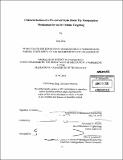Characterization of a pre-curved stylet distal tip manipulation mechanism for use in volume targeting
Author(s)
Ding, Hao, S.B. Massachusetts Institute of Technology
DownloadFull printable version (7.452Mb)
Other Contributors
Massachusetts Institute of Technology. Dept. of Mechanical Engineering.
Advisor
Alexander H. Slocum.
Terms of use
Metadata
Show full item recordAbstract
The characterization of the volume targeting capabilities of a telerobotic device capable of needle distal tip manipulation with a pre-curved needle is the focus of this thesis. The concept of deploying a pre-curved stylet from a concentric stiff cannula that is capable of both translational and rotational motions allows the device to achieve targeting of volumes through a single needle insertion into a soft medium. Each mechanism component was analyzed for its motion, and separate functional requirements were determined for experiments to characterize its accuracy and repeatability. Three main areas of mechanical studies were selected for experimentation: (1) accuracy and repeatability of the robot drive mechanisms; (2) 3D experiments measured the positional accuracies of the device in being able to command the cannula or stylet tips to travel to the desired location input into the control box; (3) 2D experiments in body tissue simulating ballistics gelatin analyzed the accuracy and repeatability of the device in being able to target a small volume inside simulated surgical environments in one plane, as well as the potential effects the gelatin may have had on the stylets' travel paths. Each set of experimental protocols and setup were specifically designed to target the characterization of that mechanism or component of the device. A kinematic model was used as a basis of comparison for the two latter experiments. The robot drive mechanism has a fundamental driving repeatability of 0.209mm in cannula axial translation, 0.034mm in stylet axial translation and 0.2200 in cannula rotation. For the 0.838mm diameter 30mm radius of curvature stylet, the stylet has an actual radius of curvature of 31.72mm as determined through a scan measurement. The tip positions experiments in the CMM and gel yielded radii of curvature changes of - 1.461mm or -4.606% between the CMM data and the actual measured stylet, and +1.202mm or +3.789% between the gel data and the stylet. 2D volume targeting experiments yielded an average distance of 1.8822mm + 0.2628mm between the measured stylet tip positions and the model based calculated positions. The stylet with the highest targeting accuracy and repeatability was the 0.838mm diameter 20mm radius of curvature stylet with a targeting accuracy of 1.2760mm ± 0.7256mm, making it the ideal stylet for use in volume targeting procedures.
Description
Thesis (S.B.)--Massachusetts Institute of Technology, Dept. of Mechanical Engineering, 2010. Cataloged from PDF version of thesis. Includes bibliographical references (p. 52).
Date issued
2010Department
Massachusetts Institute of Technology. Department of Mechanical EngineeringPublisher
Massachusetts Institute of Technology
Keywords
Mechanical Engineering.